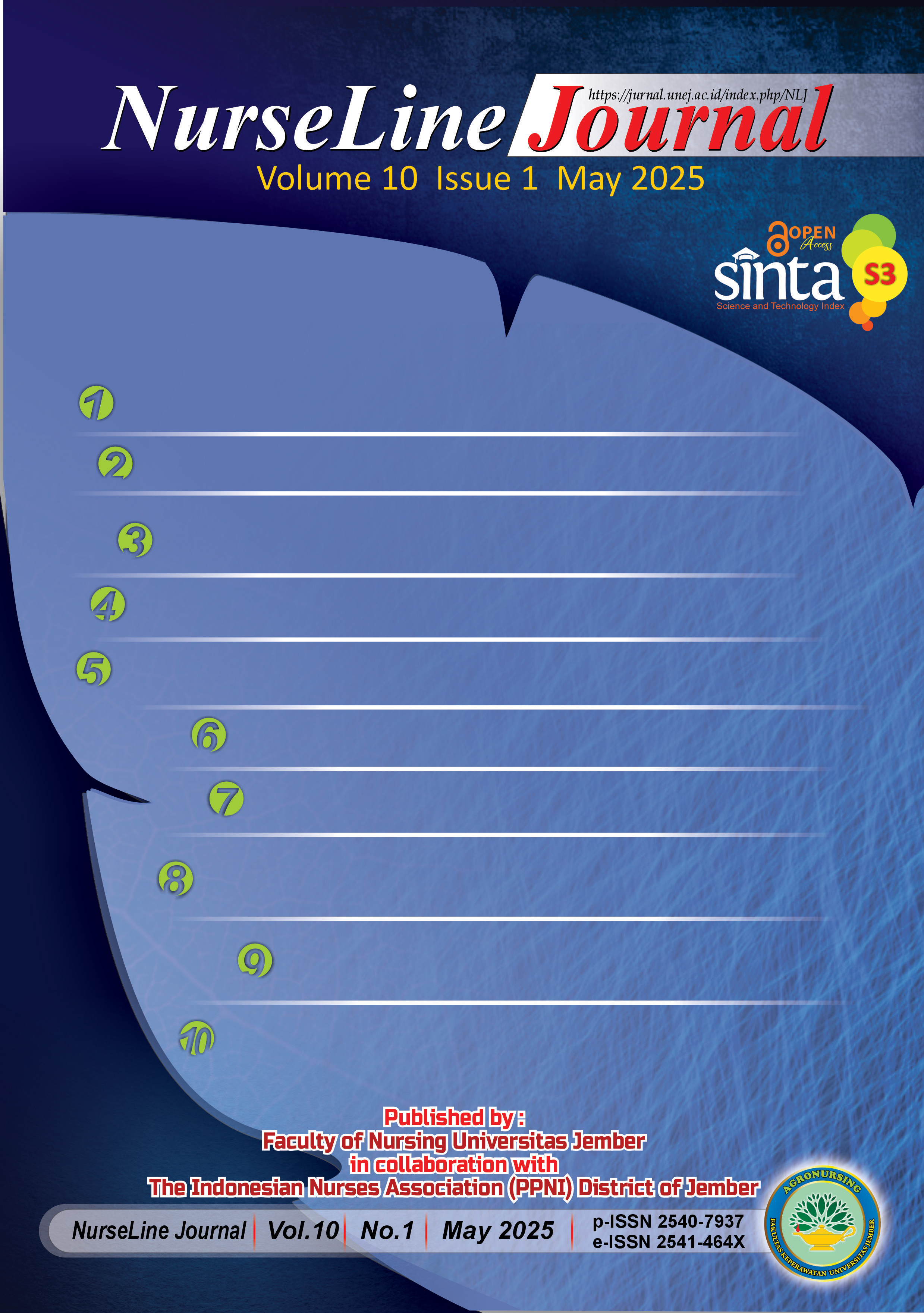Physical Activity and Sleep Disorder with Depressive Symptoms in Adolescents : A Systematic Review
DOI:
https://doi.org/10.19184/nlj.v10i1.53698Keywords:
Adolescents, Depressive symptoms, physical activity, sleep disorder, mental healthAbstract
Downloads
References
Alaie, I., Philipson, A., Ssegonja, R., Hagberg, L., Feldman, I., Sampaio, F., … Jonsson, U. (2019). Uppsala Longitudinal Adolescent Depression Study (ULADS). BMJ Open, 9(3). https://doi.org/10.1136/bmjopen-2018-024939
AlHamawi, R., Khader, Y., Abu Khudair, S., Tanaka, E., & Al Nsour, M. (2023). Mental Health and Psychosocial Problems among Children and Adolescents in Jordan: A Scoping Review. Children, Vol. 10. https://doi.org/10.3390/children10071165
Barth Vedøy, I., Skulberg, K. R., Anderssen, S. A., Fagerland, M. W., Tjomsland, H. E., & Thurston, M. (2021). The longitudinal association between objectively measured physical activity and mental health among Norwegian adolescents. International Journal of Behavioral Nutrition and Physical Activity, 18(1). https://doi.org/10.1186/s12966-021-01211-x
Bromley, K., Sacks, D. D., Boyes, A., Driver, C., & Hermens, D. F. (2024). Health enhancing behaviors in early adolescence: an investigation of nutrition, sleep, physical activity, mindfulness and social connectedness and their association with psychological distress and wellbeing. Frontiers in Psychiatry, 15. https://doi.org/10.3389/fpsyt.2024.1413268
Cheung, T., Wong, S., Wong, K., Law, L., Ng, K., Tong, M., … Yip, P. (2016). Depression, Anxiety and Symptoms of Stress among Baccalaureate Nursing Students in Hong Kong: A Cross-Sectional Study. International Journal of Environmental Research and Public Health, 13(8), 779. https://doi.org/10.3390/ijerph13080779
Demirci, K., Akgönül, M., & Akpinar, A. (2015). Relationship of smartphone use severity with sleep quality, depression, and anxiety in university students. Journal of Behavioral Addictions, 4(2). https://doi.org/10.1556/2006.4.2015.010
Dinis, J., & Bragança, M. (2018). Quality of sleep and depression in college students: A systematic review. Sleep Science, Vol. 11. https://doi.org/10.5935/1984-0063.20180045
Fairclough, S. J., Clifford, L., Brown, D., & Tyler, R. (2023). Characteristics of 24-hour movement behaviours and their associations with mental health in children and adolescents. Journal of Activity, Sedentary and Sleep Behaviors, 2(1). https://doi.org/10.1186/s44167-023-00021-9
Groves, C. I., Huong, C., Porter, C. D., Summerville, B., Swafford, I., Witham, B., … Brown, D. M. Y. (2024). Associations between 24-h movement behaviors and indicators of mental health and well-being across the lifespan: a systematic review. Journal of Activity, Sedentary and Sleep Behaviors, 3(1), 9. https://doi.org/10.1186/s44167-024-00048-6
Gu, J. (2022a). Physical Activity and Depression in Adolescents: Evidence from China Family Panel Studies. Behavioral Sciences, 12(3). https://doi.org/10.3390/bs12030071
Gu, J. (2022b). Physical Activity and Depression in Adolescents: Evidence from China Family Panel Studies. Behavioral Sciences, 12(3), 71. https://doi.org/10.3390/bs12030071
Kalak, N., Gerber, M., Kirov, R., Mikoteit, T., Pühse, U., Holsboer-Trachsler, E., & Brand, S. (2012). The relation of objective sleep patterns, depressive symptoms, and sleep disturbances in adolescent children and their parents: A sleep-EEG study with 47 families. Journal of Psychiatric Research, 46(10), 1374–1382.https://doi.org/10.1016/j.jpsychires.2012.07.006
Liu, Y., Zhang, E., Li, H., Ge, X., Hu, F., Cai, Y., & Xiang, M. (2024). Physical activity, recreational screen time, and depressive symptoms among Chinese children and adolescents: a three-wave cross-lagged study during the COVID-19 pandemic. Child and Adolescent Psychiatry and Mental Health, 18(1), 11. https://doi.org/10.1186/s13034-024-00705-3
Mandolesi, L., Polverino, A., Montuori, S., Foti, F., Ferraioli, G., Sorrentino, P., & Sorrentino, G. (2018). Effects of Physical Exercise on Cognitive Functioning and Wellbeing: Biological and Psychological Benefits. Frontiers in Psychology, 9. https://doi.org/10.3389/fpsyg.2018.00509
Noetel, M., Sanders, T., Gallardo-Gómez, D., Taylor, P., del Pozo Cruz, B., van den Hoek, D., … Lonsdale, C. (2024). Effect of exercise for depression: systematic review and network meta-analysis of randomised controlled trials. BMJ, e075847. https://doi.org/10.1136/bmj-2023-075847
Smith, M. V., & Mazure, C. M. (2021). Mental Health and Wealth: Depression, Gender, Poverty, and Parenting. Annual Review of Clinical Psychology, 17(1), 181–205. https://doi.org/10.1146/annurev-clinpsy-071219-022710
Thapar, A., Collishaw, S., Pine, D. S., & Thapar, A. K. (2012a). Depression in adolescence. The Lancet, 379(9820), 1056–1067. https://doi.org/10.1016/S0140-6736(11)60871-4
Thapar, A., Collishaw, S., Pine, D. S., & Thapar, A. K. (2012b). Depression in adolescence. The Lancet, 379(9820), 1056–1067. https://doi.org/10.1016/S0140-6736(11)60871-4
Tomáš, J., & Lenka, Š. (2023). Prevalence of Dual Diagnoses among Children and Adolescents with Mental Health Conditions. Children, 10(2). https://doi.org/10.3390/children10020293
Tremblay, M. S., Carson, V., Chaput, J. P., Connor Gorber, S., Dinh, T., Duggan, M., … Zehr, L. (2016). Canadian 24-hour movement guidelines for children and youth: An integration of physical activity, sedentary behaviour, and sleep. Applied Physiology, Nutrition and Metabolism, 41(6). https://doi.org/10.1139/apnm-2016-0151
Werneck, A. O., Silva, D. R., Malta, D. C., Souza-Júnior, P. R. B., Azevedo, L. O., Barros, M. B. A., & Szwarcwald, C. L. (2021). Physical inactivity and elevated TV-viewing reported changes during the COVID-19 pandemic are associated with mental health: A survey with 43,995 Brazilian adults. Journal of Psychosomatic Research, 140, 110292. https://doi.org/10.1016/j.jpsychores.2020.110292
WHO. (2017).
Wilhite, K., Booker, B., Huang, B. H., Antczak, D., Corbett, L., Parker, P., … Sanders, T. (2023). Combinations of Physical Activity, Sedentary Behavior, and Sleep Duration and Their Associations With Physical, Psychological, and Educational Outcomes in Children and Adolescents: A Systematic Review. American Journal of Epidemiology, Vol. 192. https://doi.org/10.1093/aje/kwac212
World Health Organization. (2016). WHO Depression factsheet. WHO.
Downloads
Published
Issue
Section
License
Copyright (c) 2025 NurseLine Journal

This work is licensed under a Creative Commons Attribution-ShareAlike 4.0 International License.








